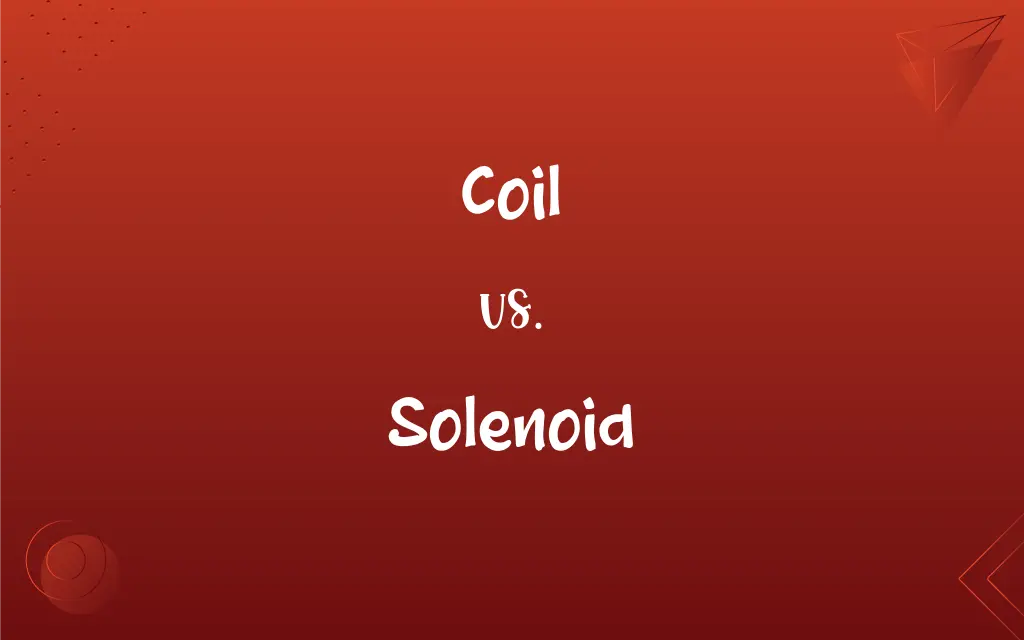Coil vs. Solenoid: What's the Difference?
By Harlon Moss || Updated on May 23, 2024
A coil is a wire wound into a helical shape used in various electrical applications, while a solenoid is a specific type of coil designed to produce a magnetic field when an electric current passes through it.

Key Differences
A coil is a wire wound into a spiral or helical shape and is used in many electrical devices for purposes such as inducing magnetic fields, inductance, and resistance. Coils are found in transformers, inductors, and electromagnets, serving a variety of functions in electrical circuits. A solenoid, on the other hand, is a specific type of coil that is designed to generate a uniform magnetic field when an electric current flows through it. Solenoids typically consist of a cylindrical coil of wire and are often used as electromagnets or in applications where controlled movement or actuation is needed, such as in valves, switches, and relays.
In terms of function, a coil can have various applications in electrical circuits, while a solenoid's primary purpose is to act as an electromagnet to create linear motion or force. The design of solenoids often includes an iron core to enhance the magnetic field, whereas coils may or may not have such cores depending on their intended use.
Coils are versatile and can be used in AC and DC circuits, whereas solenoids are often used in DC circuits to control mechanical actions. The distinction lies in their specific uses and the focused application of solenoids in converting electrical energy to mechanical energy.
Comparison Chart
Definition
Wire wound into a helical shape
Cylindrical coil designed to produce a magnetic field
Primary Function
Inductance, resistance, and energy storage
Actuation and electromagnetism
ADVERTISEMENT
Application
Transformers, inductors, electromagnets
Valves, switches, relays
Magnetic Field
Can produce a magnetic field
Designed to produce a uniform magnetic field
Core
May or may not have a core
Often includes an iron core
Circuit Type
Used in AC and DC circuits
Typically used in DC circuits
Coil and Solenoid Definitions
Coil
A wire wound into a spiral or helical shape.
The coil in the transformer helps to regulate voltage.
ADVERTISEMENT
Solenoid
A cylindrical coil of wire designed to produce a magnetic field.
The solenoid in the lock activated to open the door.
Coil
A component used to induce magnetic fields.
The coil created a magnetic field that influenced nearby objects.
Solenoid
Often includes an iron core to enhance the magnetic field.
The solenoid’s core increased the strength of the magnetic field.
Coil
Can be found in various electrical devices.
Coils are integral to the function of electromagnets.
Solenoid
An electromagnetic device for controlling mechanical movements.
The solenoid valve controlled the flow of water.
Coil
Used to filter electrical signals.
The coil filtered out noise from the signal.
Solenoid
Converts electrical energy into mechanical motion.
When powered, the solenoid moved the piston.
Coil
A series of connected spirals or concentric rings formed by gathering or winding
A coil of rope.
Long coils of hair.
Solenoid
A current-carrying coil of wire that acts like a magnet when a current passes through it.
Coil
An individual spiral or ring within such a series.
Solenoid
An assembly used as a switch, consisting of a coil and a metal core free to slide along the coil axis under the influence of the magnetic field.
Coil
A spiral pipe or series of spiral pipes, as in a radiator.
Solenoid
(physics) A coil of wire that acts as a magnet when an electric current flows through it.
Coil
A wound spiral of two or more turns of insulated wire, used to introduce inductance into a circuit.
Solenoid
(engineering) An electromechanical device consisting of such a coil containing a metal core, the movement of which is controlled by the current.
Coil
Any of various devices of which such a spiral is the major component.
Solenoid
(electronics) An electromechanical switch controlled by a solenoid; solenoid switch, relay.
Coil
A roll of postage stamps prepared for use in a vending machine.
Solenoid
(meteorology) The region of intersection between isobaric and isopycnal surfaces.
Coil
A disturbance; a fuss.
Solenoid
An electrodynamic spiral having the conjuctive wire turned back along its axis, so as to neutralize that component of the effect of the current which is due to the length of the spiral, and reduce the whole effect to that of a series of equal and parallel circular currents. When traversed by a current the solenoid exhibits polarity and attraction or repulsion, like a magnet.
Coil
To wind in concentric rings or spirals.
Solenoid
A coil of wire around an iron core; becomes a magnet when current passes through the coil
Coil
To wind into a shape resembling a coil.
Solenoid
Used in applications requiring linear motion.
Solenoids are commonly used in automotive starters.
Coil
To form concentric rings or spirals.
Coil
To move in a spiral course
Black smoke coiling up into the sky.
Coil
Something wound in the form of a helix or spiral.
The sinuous coils of a snake
Coil
Any intrauterine device (Abbreviation: IUD)—the first IUDs were coil-shaped.
Coil
(electronics) A coil of electrically conductive wire through which electricity can flow.
Coil
A cylinder of clay.
Coil
(figurative) Entanglement; perplexity.
Coil
A noise, tumult, bustle, or turmoil.
Coil
To wind or reel e.g. a wire or rope into regular rings, often around a centerpiece.
A simple transformer can be made by coiling two pieces of insulated copper wire around an iron heart.
Coil
To wind into loops (roughly) around a common center.
The sailor coiled the free end of the hawser on the pier.
Coil
To wind cylindrically or spirally.
To coil a rope when not in use
The snake coiled itself before springing.
Coil
To build a pot (etc) with clay coils.
Coil
To encircle and hold with, or as if with, coils.
Coil
To wind cylindrically or spirally; as, to coil a rope when not in use; the snake coiled itself before springing.
Coil
To encircle and hold with, or as with, coils.
Coil
To wind itself cylindrically or spirally; to form a coil; to wind; - often with about or around.
You can see his flery serpents . . . Coiting, playing in the water.
Coil
A ring, series of rings, or spiral, into which a rope, or other like thing, is wound.
The wild grapevines that twisted their coils from trec to tree.
Coil
Fig.: Entanglement; toil; mesh; perplexity.
Coil
A series of connected pipes in rows or layers, as in a steam heating apparatus.
Coil
A noise, tumult, bustle, or confusion.
Coil
A structure consisting of something wound in a continuous series of loops;
A coil of rope
Coil
A round shape formed by a series of concentric circles
Coil
A transformer that supplies high voltage to spark plugs in a gasoline engine
Coil
A contraceptive device placed inside a woman's womb
Coil
Tubing that is wound in a spiral
Coil
Reactor consisting of a spiral of insulated wire that introduces inductance into a circuit
Coil
To wind or move in a spiral course;
The muscles and nerves of his fine drawn body were coiling for action
Black smoke coiling up into the sky
The young people gyrated on the dance floor
Coil
Make without a potter's wheel;
This famous potter hand-builds all of her vessels
Coil
Wind around something in coils or loops
Coil
Used for inductance in electronic circuits.
The inductor coil stored energy in its magnetic field.
FAQs
Can a coil be used in both AC and DC circuits?
Yes, coils can be used in both AC and DC circuits.
How does a coil function in an electrical circuit?
A coil functions by inducing magnetic fields, storing energy, and providing inductance or resistance.
What applications use coils?
Coils are used in transformers, inductors, electromagnets, and signal filtering.
What is a solenoid?
A solenoid is a cylindrical coil of wire designed to produce a magnetic field and often used as an electromagnet.
What is a coil?
A coil is a wire wound into a helical shape used in various electrical applications.
How does a solenoid function?
A solenoid functions by generating a magnetic field that can move a core, converting electrical energy into mechanical motion.
Are solenoids typically used in AC or DC circuits?
Solenoids are typically used in DC circuits.
What applications use solenoids?
Solenoids are used in valves, switches, relays, and actuators.
Do solenoids usually have cores?
Yes, solenoids often include an iron core to enhance the magnetic field.
What is the primary purpose of a solenoid?
The primary purpose of a solenoid is to act as an electromagnet to create linear motion or force.
Can solenoids be used to filter signals?
No, solenoids are not used to filter signals; they are used for actuation and electromagnetism.
Do all coils have cores?
No, not all coils have cores; it depends on their application.
Can coils be used to filter signals?
Yes, coils can be used to filter electrical signals.
Can a coil generate a magnetic field?
Yes, a coil can generate a magnetic field when an electric current flows through it.
Do coils play a role in energy storage?
Yes, coils store energy in their magnetic field when current flows through them.
What enhances the magnetic field in a solenoid?
The iron core in a solenoid enhances the magnetic field.
How does a solenoid create motion?
A solenoid creates motion by generating a magnetic field that moves a core inside the coil.
Are solenoids used in automotive applications?
Yes, solenoids are commonly used in automotive starters and other control systems.
What is the primary purpose of a coil?
The primary purpose of a coil is to provide inductance, resistance, and energy storage in electrical circuits.
What differentiates a coil from a solenoid in terms of design?
A coil is simply a wire wound into a helical shape, while a solenoid is a cylindrical coil specifically designed to produce a magnetic field and often includes an iron core.
About Author
Written by
Harlon MossHarlon is a seasoned quality moderator and accomplished content writer for Difference Wiki. An alumnus of the prestigious University of California, he earned his degree in Computer Science. Leveraging his academic background, Harlon brings a meticulous and informed perspective to his work, ensuring content accuracy and excellence.































































